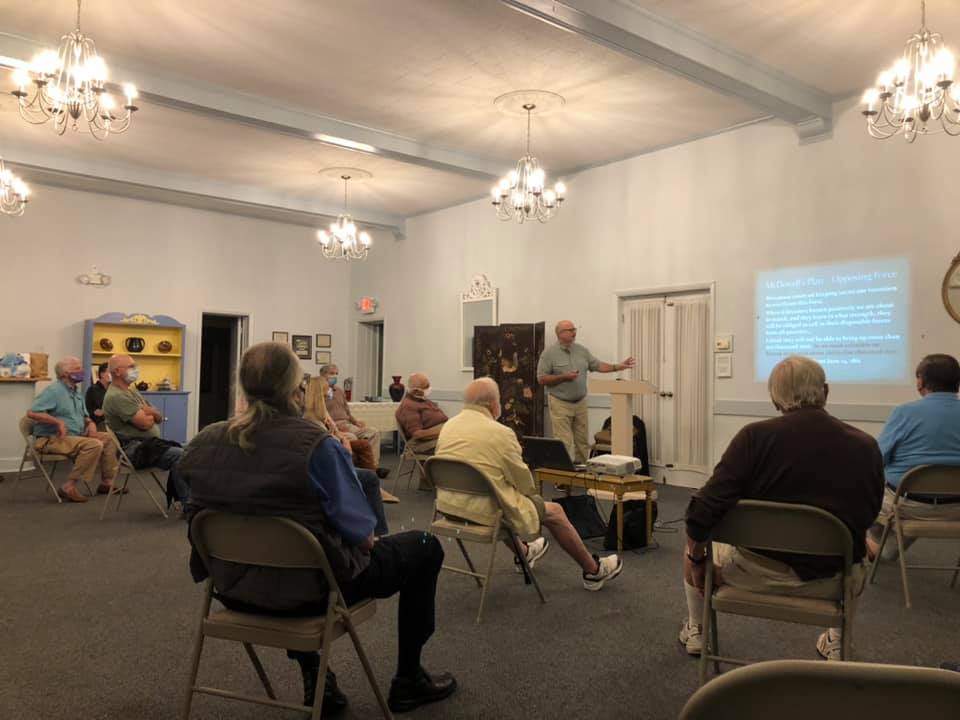Correspondence of the Times.
8th Regiment,
Arlington Heights, Va., July 25th.
Receiving orders on Saturday, July 20th, to prepare for marching on the following morning, we filled our haversacks with biscuit and pork, for three days rations, and got everything in readiness to move forward at two o’clock A. M. As the day wore away, I noticed that other Regiments in our vicinity, were making the same preparations, and rumor was busy, as to where our next halting place would be, it was expected that we should have a brush with the enemy, but we did not expect it to turn out as it did. As night came on, our boys threw themselves on the ground to get a little rest, before the march began; it was rather a cold windy night, and laying on the ground in Virginia, (where dews are heavy, is not very pleasant.) I endeavored to sleep, but being so cold, I arose, and building a fire, some dozen of us laid around till one o’clock, when we commenced to get things ready, to fall in. Rolling our blankets, filling our canteens with water, with our muskets bright, ammunition all right, we formed company and fell into line. It is a singular sight to see Regiment after Regiment fall into its alloted place, not a drum was heard, nothing could be seen but the Camp Fires of the different camps. And the forests of flashing muskets of out men. Taking the road through the village of Centreville, and passing several Regiments in reserve, the advance column, came to a small wooden bridge, a short distance from which the Rebels were supposed to have erected a Battery. The plan of the attack seems to have been to have attacked them on two points at the same time. The advanced column consisting of about 9,000 men, under General Tyler, was to take the mountain road and attack the enemy in front, while Col. Hunter’s division of 13,000 men were to take a circuit through the woods to the right, and attack them in rear. In the flanking division was the 8th and 27th, also the 14th and 71st of New York, 2d Regiment of Regulars, and battery of artillery. Halting for a short time, to give the first division time to advance to the top of the hull, which we could see from the Bridge, we for the first time, heard the report of artillery, which was the 32 pounder our advance column had with them, trying its range on a force of the Rebels, which they could see at a distance. Our division now crossed the bridge, and leaving the central column, struck to the right, through the woods. After marching four or five miles we came to an open field, and expected the enemy would open fire, but there were none to be seen, every thing was as quiet on that Saturday night as if there were not a Rebel within mile around, but they were drawing us on (as in ou retreat over the same ground, they opened fire from concealed batteries.) Crossing the open space, we again took to the woods, and after a fatiguing march of some eight miles, again came to the open country, it was now between 9 and 10 o’clock, and we were beginning to get tired out, and wanted some refreshments, as out last meal was 6 o’clock the day before, the sun now began to tell upon us, and at every hold our boys would run to the trees, or any shady place to shelter from its scorching rays. Constant reports of artillery could now be heard, and as we came to an eminence we could see the smoke rise from the batteries of the opposing forces, while still farther to our left could be seen clouds of dust, as of large bodies of men moving along the road, we were anticipating it was ‘Patterson’s Division,’ instead of which, it turned out to be Johnson’s. We were now halted down in a meadow and laid our muskets down, expecting we had out-flanked the enemy, and they would retreat that way, when we should be able to capture them, (pleasant delusion, but of short duration) we had just commenced to open our haversacks to get a bite, when the order was given to fall in, and off we started on the double quick, for the battle field, through a creek, up to our knees in mud an water, and down the Road we ran, As the sound of artillery now became louder, and more frequent, we passed on still faster, throwing our blankets and haversacks by the road side, and grasping our muskets tighter, we still pressed on. A United States officer now rode by and made the remark not to be too hasty, as we should have enough before night. – We now came upon the scene of action, a large open space, surrounded by woods, in which were concealed the enemies infantry, while in front were their batteries, charging over the field, we came upon the Rebels in a clump of woods, After leaving some of our men, we drove them out and back into their entrenchments; meanwhile the Rebels had got the range of us with their guns, and poured in heavy charges of grape and canister, killing and wounding our boys in a frightful manner. We now fell back, and took a position on the hill, facing the Rebel earthworks, a brisk fire of musketry was now kept up on both sides, fortunately the aim of the enemy was bad, most of their balls, going over our heads. The enemy still kept up a sharp fire, and seemed to have double the number of guns in play we had, but their fire was not so effectual as ours, we could see our shot and shell fall into their batteries, and towards the afternoon an explosion took place, which blew some of them into the air. Our Brigade was now ordered again to endeavor to capture the battery on our left. With others, we marched over the brow of the hill, and charged up towards the Rebels, when they opened with heavy discharges of musketry, which we returned with interest. Several of my comrades now fell; on we went till within short range of the Rebel guns, when they opened a terrific fire upon us, the round shot and shell ploughed through our ranks. Our Brigade was now badly cut up. The dead and wounded were lying around in all directions, dreadfully mutilated. It was a disheartening prospect before us, 40 miles to our camp in Arlington, with no refreshments, nothing but dirty water to drink, and not enough of that, with a sanguine and merciless foe upon us. As we retreated I found the Regiments all mixed up, and every man making the best of his way back, few officers were to be seen, most of them having left their men to get back as best they could. There were [?], such as Governor Sprague. If the officers had kept with their men they could have retired in good order [?…] orderly retreats. The road was narrow and partly blocked up with wagons and ambulance for the wounded. Some of the men (to their disgrace) threw away their muskets and ammunition, and placed on gun carriages. – After marching some 7 miles, some of the poor fellow’s began to give out, and crawled into the woods, where they were probably taken by the enemy. I could now hear the report of Rifled Artillery, and began to think the Rebels had cut off our retreat. – Still onward, was the road to Centreville. – Crossing the open space, which I mentioned before, I found the enemy playing upon our retreating forces, those that could, took to the woods on the left. While the long line of ambulances and wagons kept straight on the road. As night came I reached the open road, where we had left the centre column in the morning, with such exultation. What a change now, as we went to battle in all the pomp of war, we looked in fact, invincible, but were now returning a disorganized mass of humanity. We had brought nearly all our cannon from the battle field, but as we came toward the bridge, had to leave some behind. The enemy allowed us to pass in the morning without interruption, but were now hitting the bridge most accurately with shot and shell, while another battery was playing with grape and canister on our poor fellows, passing down the road towards the bridge, the dead and wounded teamsters were laying by, just as they fell from their horses, while some of the ambulances were upset, and the wounded thrown out to be left at the mercy of the enemy. Arriving at the bridge, I found it blocked up with broken wagons, dead men, and horses, so that we could not possibly pass. Most of the men made their way through the water, while over their heads rattled the cannon balls. Crossing the river we got into the woods, but were not safe from the enemy’s artillery, their shot and shell came down amongst us, and fell and exploded not a yard from me. Feet sore and exhausted, I at last arrived at our camping grounds of the previous night, – a little rest, and onward again. From Centreville to Arlington, is 22 miles, as the night wore on some of our boys gave out, some took off their shoes and stockings and limped along as best they could. I got into camp about 10 o’clock next morning, and was right glad to get a cup of coffee once more. We had marched from Centreville on Sunday night from 2 till 11 A. M., had fought 6 hours on the battle field, and retreated forty miles in thirty-six hours.
W. D.
Oxford (NY) Times, 8/14/1861
Clipping image
Contributed by John Hennessy

























Recent Comments